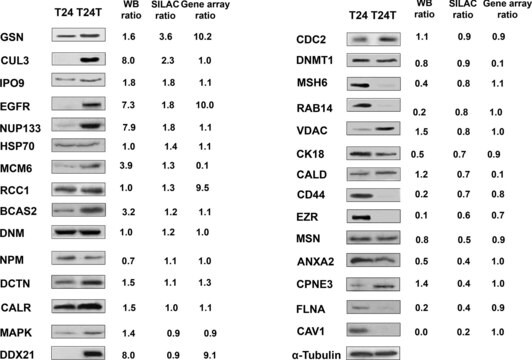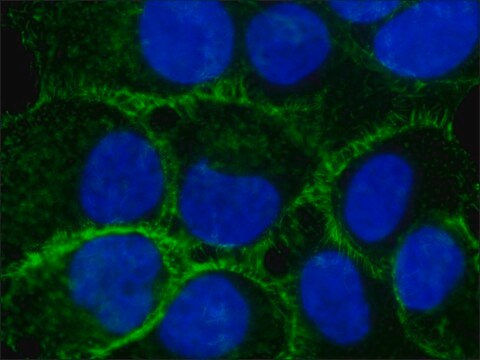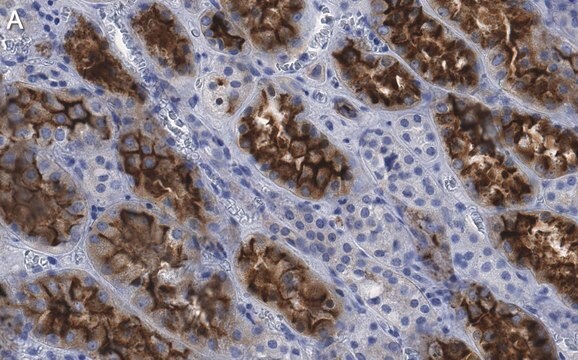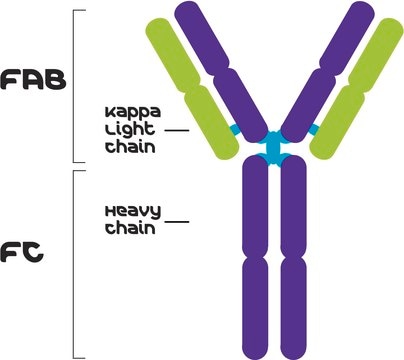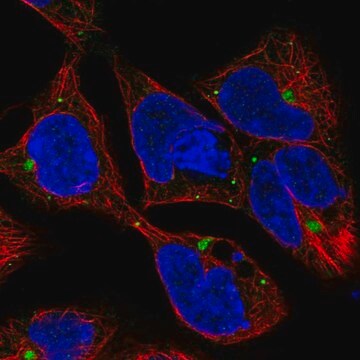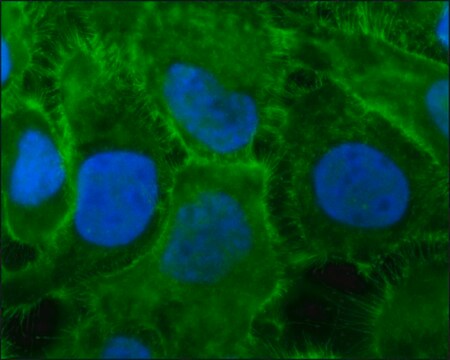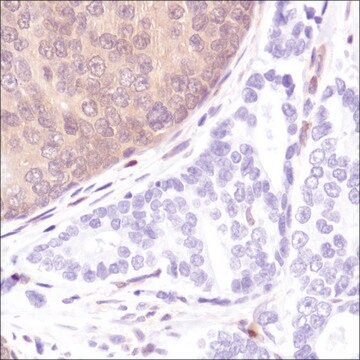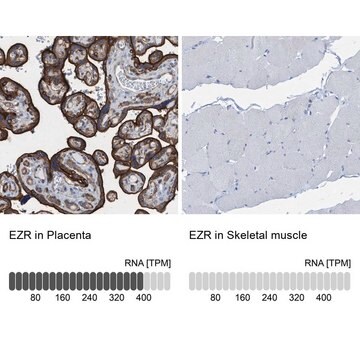推荐产品
生物源
mouse
品質等級
抗體表格
purified immunoglobulin
抗體產品種類
primary antibodies
無性繁殖
4A5, monoclonal
物種活性
human, rat, rabbit, mouse
技術
electron microscopy: suitable
immunocytochemistry: suitable
immunohistochemistry: suitable
immunoprecipitation (IP): suitable
western blot: suitable
同型
IgG1κ
NCBI登錄號
UniProt登錄號
運輸包裝
wet ice
目標翻譯後修改
unmodified
基因資訊
human ... EZR(7430)
一般說明
Ezrin (UniProt Q8HZQ5; also known as Cytovillin, Villin-2, p81) is encoded by the EZR (also known as VIL2) gene (Gene ID 100008846) in Oryctolagus cuniculus (Rabbit) species. Ezrin, radixin, and moesin are the three ERM protein family members that crosslink actin filaments with plasma membranes and play an important role in the cell cortex architecture. In its inactive state, ezrin is located in the cytosol in a conformation involving intramolecular interaction between its N- and C-terminal. Ezrin is activated by phosphorylation, which causes a conformation change that disrupts the head-to-tail intramolecular interaction. Upon activation, ezrin binds to the cytoplasmic tails of multiple adhesion and signaling membrane molecules, such as CD44, growth factor receptors, and vascular adhesion molecule (VCAM1). The initiator methionine of ezrin is removed posttranslationally to yield the mature protein (a.a. 2-586) with an N-termina FERM domain (a.a. 2-295) that mediates interaction with microtubules.
特異性
Clone 4A5 reacted with both dentured and non-denatured Ezrin (Hanzel, D.K., et al. (1989). Am. J. Physiol. 256(6 Pt 1):G1082-G1089).
免疫原
Purified Ezrin from rabbit gastric parietal cells.
應用
Anti-Ezrin Antibody, clone 4A5, Ascites Free is an antibody against Ezrin for use in Western Blotting, Immunohistochemistry, Immunoprecipitation, Electron Microscopy, Immunocytochemistry.
Research Category
Cell Structure
Cell Structure
Research Sub Category
Adhesion (CAMs)
Adhesion (CAMs)
Western Blotting Analysis: 0.5 µg/mL of this antibody from a representative lot detected Ezrin in 10 µg of HeLa cell lysate.
Immunohistochemistry Analysis: A representative lot detected a higher Ezin immunoreactivity in paraffin-embedded human medulloblastoma sections when compared with normal cerebellum sections (Haeberle, H., et al. (2012). Neoplasia. 14(7):666-669).
Immunohistochemistry Analysis: A representative lot immunostained parietal cells in rabbit gastric mucosa (Hanzel, D.K., et al. (1989). Am. J. Physiol. 256(6 Pt 1):G1082-G1089).
Immunoprecipitation Analysis: A representative lot immunoprecipitated Ezin from human A431 cells. The immunoprecipitated Ezrin was phosphorylated on Ser66 from dbcAMP‐treated, but not cAMP‐treated, A431 cells (Wang, S., et al. (2009). Cell Res. 19(12):1350-1362).
Electron Microscopy Analysis: A representative lot detected Ezrin on microvilli of the intracellular canaliculi (IC) and the subapical region of resting parietal cells in Lowicryl HM20-embedded rabbit gastric gland ultrathin sections (Sawaguchi, A., et al. (2004). J. Histochem. Cytochem. 52(1): 77–86).
Immunocytochemistry Analysis: A representative lot detected exogenously expressed human GST fusion protein by fluorescent immunocytochemistry staining of formaldehyde-fixed, Triton X-100-permeabilized rabbit gastric parietal cells (Zhou, R., et al. (2003). J. Biol. Chem. 278(37):35651-35659).
Western Blotting Analysis: A representative lot detected both the endogenous rabbit Ezrin as well as exogenously expressed human Ezrin GST fusion proteins in transfected rabbit gastric parietal cells (Zhou, R., et al. (2003). J. Biol. Chem. 278(37):35651-35659).
ELISA Analysis: Clone 4A5 hybridoma culture supernatant was screened for its immunoreactivity by ELISA and found to react with both dentured and non-denatured 80 kDa Ezrin preparations from rabbit gastric glands/mucosa vesicular fractions (Hanzel, D.K., et al. (1989). Am. J. Physiol. 256(6 Pt 1):G1082-G1089).
Immunohistochemistry Analysis: A representative lot detected a higher Ezin immunoreactivity in paraffin-embedded human medulloblastoma sections when compared with normal cerebellum sections (Haeberle, H., et al. (2012). Neoplasia. 14(7):666-669).
Immunohistochemistry Analysis: A representative lot immunostained parietal cells in rabbit gastric mucosa (Hanzel, D.K., et al. (1989). Am. J. Physiol. 256(6 Pt 1):G1082-G1089).
Immunoprecipitation Analysis: A representative lot immunoprecipitated Ezin from human A431 cells. The immunoprecipitated Ezrin was phosphorylated on Ser66 from dbcAMP‐treated, but not cAMP‐treated, A431 cells (Wang, S., et al. (2009). Cell Res. 19(12):1350-1362).
Electron Microscopy Analysis: A representative lot detected Ezrin on microvilli of the intracellular canaliculi (IC) and the subapical region of resting parietal cells in Lowicryl HM20-embedded rabbit gastric gland ultrathin sections (Sawaguchi, A., et al. (2004). J. Histochem. Cytochem. 52(1): 77–86).
Immunocytochemistry Analysis: A representative lot detected exogenously expressed human GST fusion protein by fluorescent immunocytochemistry staining of formaldehyde-fixed, Triton X-100-permeabilized rabbit gastric parietal cells (Zhou, R., et al. (2003). J. Biol. Chem. 278(37):35651-35659).
Western Blotting Analysis: A representative lot detected both the endogenous rabbit Ezrin as well as exogenously expressed human Ezrin GST fusion proteins in transfected rabbit gastric parietal cells (Zhou, R., et al. (2003). J. Biol. Chem. 278(37):35651-35659).
ELISA Analysis: Clone 4A5 hybridoma culture supernatant was screened for its immunoreactivity by ELISA and found to react with both dentured and non-denatured 80 kDa Ezrin preparations from rabbit gastric glands/mucosa vesicular fractions (Hanzel, D.K., et al. (1989). Am. J. Physiol. 256(6 Pt 1):G1082-G1089).
品質
Evaluated by Western Blotting in L6 rat myoblast lysate.
Western Blotting Analysis: 0.5 µg/mL of this antibody detected Ezrin in 10 µg of L6 rat myoblast lysate.
Western Blotting Analysis: 0.5 µg/mL of this antibody detected Ezrin in 10 µg of L6 rat myoblast lysate.
標靶描述
~75 kDa observed. 69.41 kDa (Human/UniProt P15311 & Mouse/P26040), 69.39 kDa (Rat/UniProt P31977), and 69.22 kDa (Rabbit/Q8HZQ5) calculated. Uncharacterized band(s) may appear in some lysates.
外觀
Protein G Purified
Format: Purified
Purified mouse monoclonal IgG1κ antibody in buffer containing 0.1 M Tris-Glycine (pH 7.4), 150 mM NaCl with 0.05% sodium azide.
儲存和穩定性
Stable for 1 year at 2-8°C from date of receipt.
其他說明
Concentration: Please refer to lot specific datasheet.
免責聲明
Unless otherwise stated in our catalog or other company documentation accompanying the product(s), our products are intended for research use only and are not to be used for any other purpose, which includes but is not limited to, unauthorized commercial uses, in vitro diagnostic uses, ex vivo or in vivo therapeutic uses or any type of consumption or application to humans or animals.
未找到合适的产品?
试试我们的产品选型工具.
儲存類別代碼
12 - Non Combustible Liquids
水污染物質分類(WGK)
WGK 1
閃點(°F)
Not applicable
閃點(°C)
Not applicable
M Motiur Rahman et al.
Cells, 10(3) (2021-04-04)
In Inflammatory Bowel Disease (IBD), malabsorption of electrolytes (NaCl) results in diarrhea. Inhibition of coupled NaCl absorption, mediated by the dual operation of Na:H and Cl:HCO3 exchangers on the brush border membrane (BBM) of the intestinal villus cells has been
M Motiur Rahman et al.
International journal of molecular sciences, 22(8) (2021-05-01)
Electrolytes (NaCl) and fluid malabsorption cause diarrhea in inflammatory bowel disease (IBD). Coupled NaCl absorption, mediated by Na+/H+ and Cl-/HCO3- exchanges on the intestinal villus cells brush border membrane (BBM), is inhibited in IBD. Arachidonic acid metabolites (AAMs) formed via
Molly Butts et al.
The Journal of nutrition, 150(4), 747-755 (2019-11-27)
Chronic alcohol use often leads to malnutrition. However, how the intestinal absorption of nutrients such as glucose may be affected during moderate ethanol use has not been investigated. Glucose is absorbed via sodium (Na)-dependent glucose co-transport (SGLT1; SLC5A1) along the
我们的科学家团队拥有各种研究领域经验,包括生命科学、材料科学、化学合成、色谱、分析及许多其他领域.
联系技术服务部门